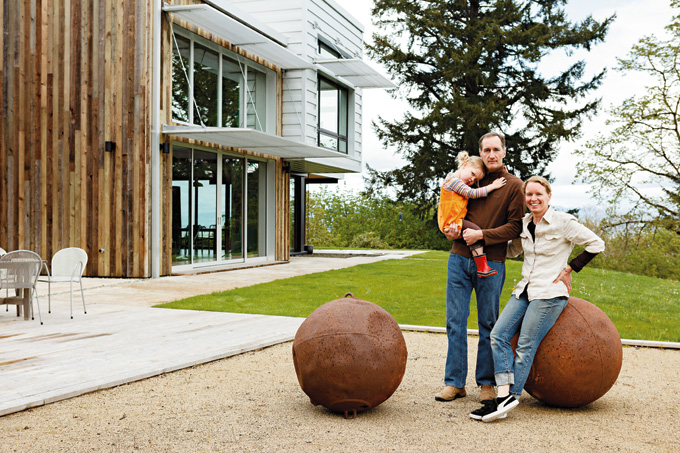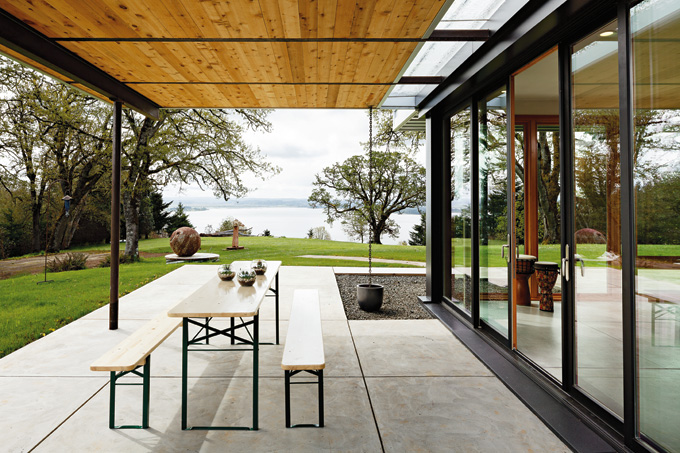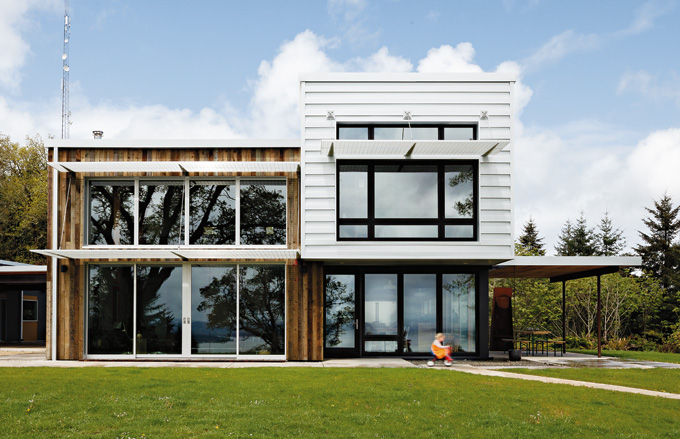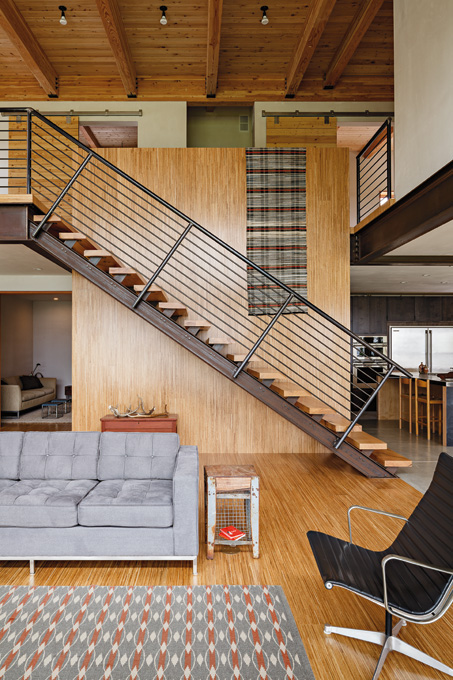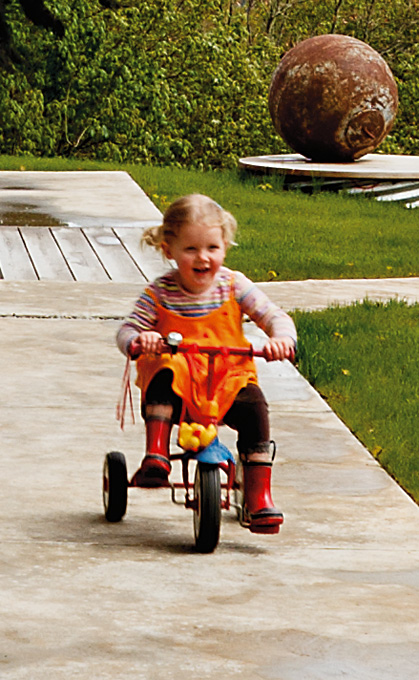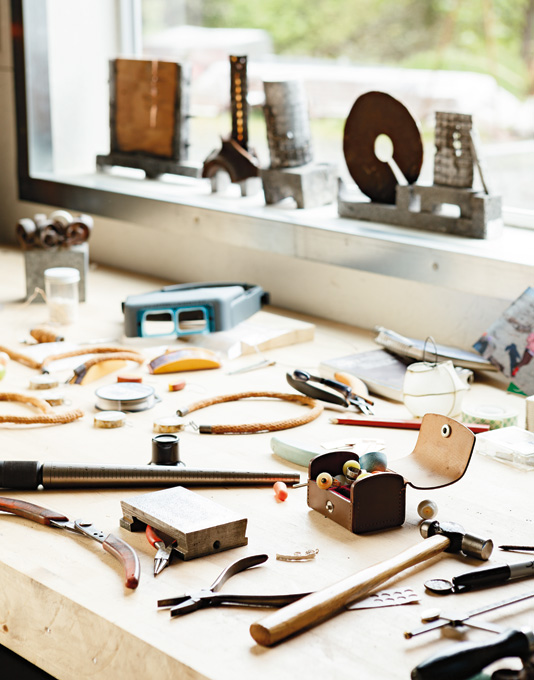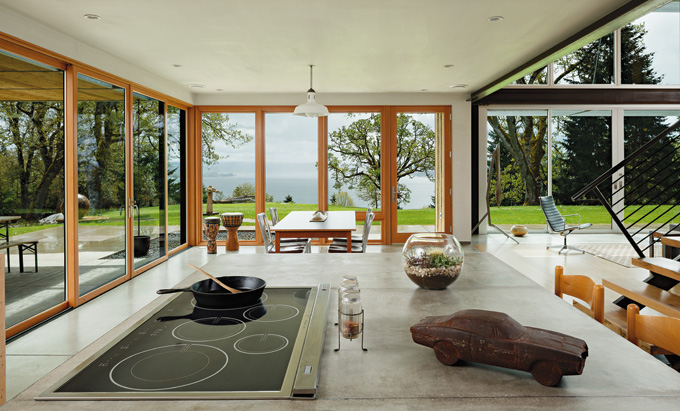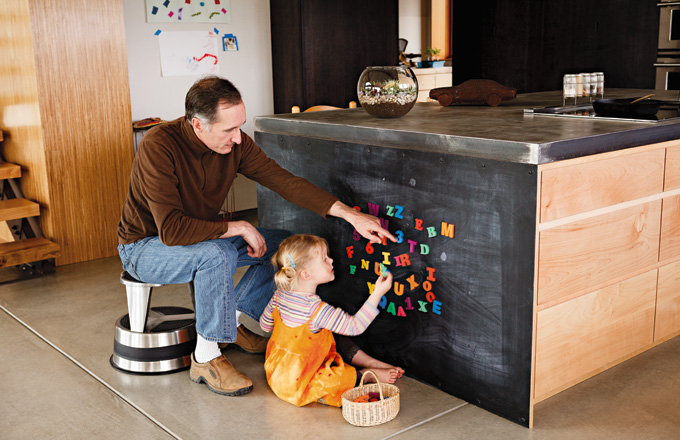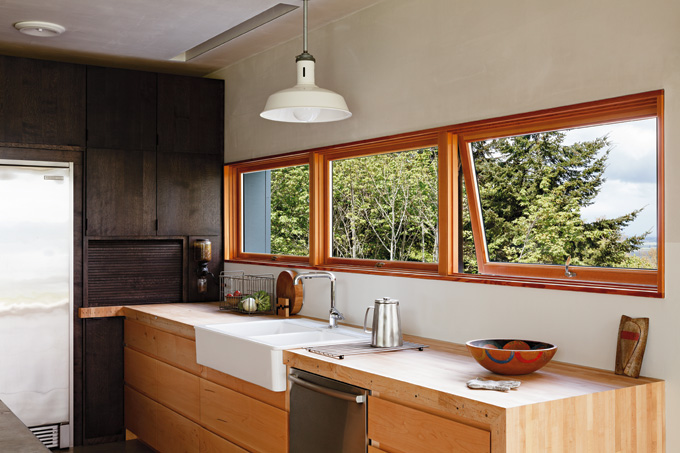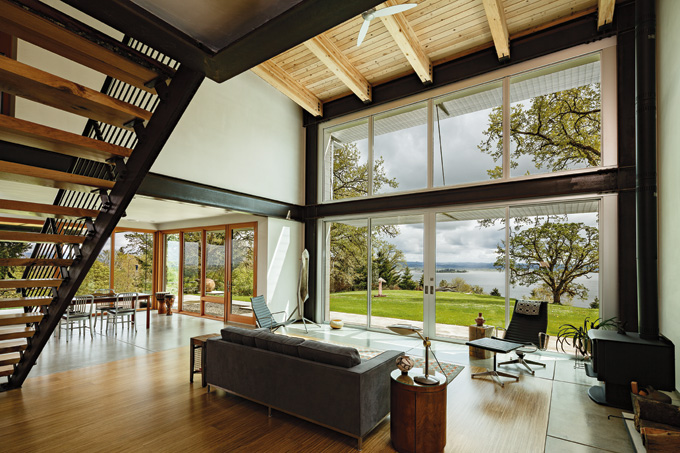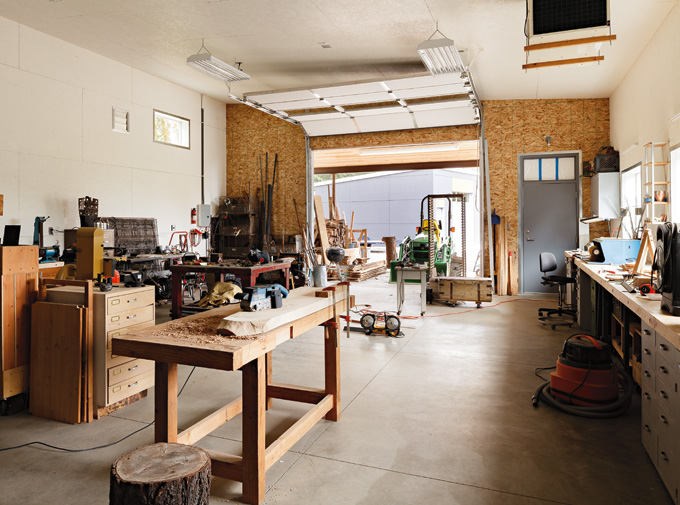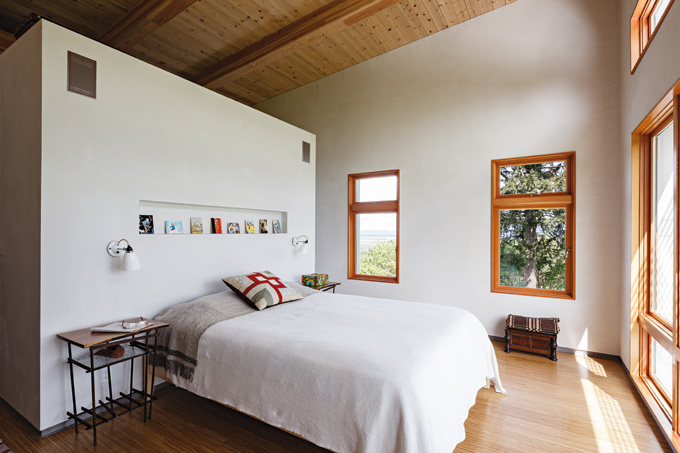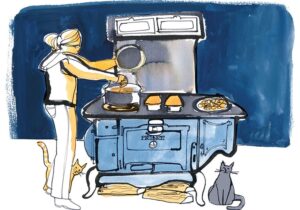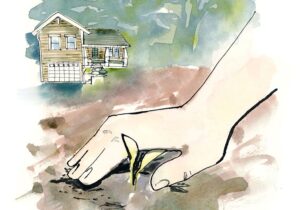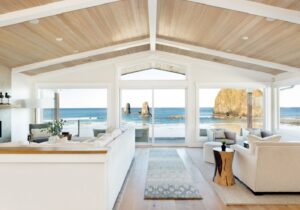{artsexylightbox}{/artsexylightbox}
Sarah Peterman has always enjoyed scanning lists of homes and properties for sale, and when she and Tim Gift were sailing one day on Fern Ridge Reservoir near Eugene, she looked up at the bluff above and recognized a piece of property by a tree at its edge. “We knew we wanted to live on a place like that someday,” she says. “I began to follow this property, not realizing that someday we’d actually own it.”
In early 2009, just before their daughter, Ada, was born, the couple closed on the 30-acre piece of land. Peterman, a metal artist, and Gift, a software developer, knew that if they were going to build, they wanted a home that fit their lifestyle and incorporated as many sustainable features as possible. To help design the home, they hired Jan Fillinger, the principal at Studio-e Architecture in Eugene. “Sarah and Tim were fun clients because they were interested in the home’s sustainable and design elements,” says Fillinger. “The house has a lot of interesting and creative touches because of that.”
{besps}articles/2012/2012_GreenLiving/LakeHouse|width=680|height=500{/besps}
{besps_c}0|01.jpg|The lakeside home of Sarah Peterman and Tim Gift was sustainably built with recycled materials, solar energy and low-maintenance construction.|PHOTO LINCOLN BARBOUR{/besps_c}
{besps_c}0|02.jpg|Tim Gift and his daughter, Ada, at her magnetic ABC board.|PHOTO LINCOLN BARBOUR{/besps_c}
{besps_c}0|03.jpg|Countertops were made from old bowling alley wood; a coffee grinder is conveniently placed.|PHOTO LINCOLN BARBOUR{/besps_c}
{besps_c}0|04.jpg|The living/dining area is open to the outdoors and flooded with natural light.|PHOTO LINCOLN BARBOUR{/besps_c}
{besps_c}0|05.jpg|A local neighbor wanders by looking for company — or a snack.|PHOTO LINCOLN BARBOUR{/besps_c}
{besps_c}0|06.jpg|The home has commanding views of the Fern Ridge Reservoir.|PHOTO LINCOLN BARBOUR{/besps_c}
{besps_c}0|07.jpg|The open staircase’s treads were made from black oak felled and milled on the property; the railing is made from exposed metal beams and bolts..|PHOTO LINCOLN BARBOUR{/besps_c}
{besps_c}0|08.jpg|The master bedroom on the second floor is open to nature and light.|PHOTO LINCOLN BARBOUR{/besps_c}
{besps_c}0|09.jpg|The fiber cement panels were installed wrong-side out; the corrugated metal siding is meant to last for 50 years.|PHOTO LINCOLN BARBOUR{/besps_c}
{besps_c}0|10.jpg|Recycled barn-wood siding clads most of the outside of the house.|PHOTO LINCOLN BARBOUR{/besps_c}
{besps_c}0|11.jpg|Sarah Peterman in her 2,800-square-foot workshop, which includes her art studio.|PHOTO LINCOLN BARBOUR{/besps_c}
{besps_c}0|12.jpg|The large workshop also provided space for construction projects during the building of the house. |PHOTO LINCOLN BARBOUR{/besps_c}
{besps_c}0|13.jpg|Sarah Peterman is a metalworks artist; many of her pieces adorn her house and property.|PHOTO LINCOLN BARBOUR{/besps_c}
{besps_c}0|14.jpg|A welded steel sculpture by David P. Miller titled “Bamboo.”|PHOTO LINCOLN BARBOUR{/besps_c}
{besps_c}0|15.jpg| Floor plans for the Peterman/Gift home.|{/besps_c}
{artsexylightbox}{/artsexylightbox}
The property consists of a garage, a large studio and a 2,900-square-foot house. The house, completed in late 2011, was built last. “We built the others first to test materials and design ideas,” says Gift. “Each building is a simple shape, a cube, which helps save on costs.” The studio, which contains an arts-and-crafts area as well as metalworking and woodworking areas, is connected to the house by a large deck and a covered carport.
The focal point of the three-bedroom, three-bath house is the dramatic floating staircase and partial wall in the L-shape great room. The engineered oak floor in the living room doesn’t stop at the wall. Instead, the wall is covered with the same wood, making it appear that the floor travels up and over the wall to the landing of the loft-style second floor. The staircase, whose treads were made from some black oak felled and milled on the property, has a railing made from exposed metal beams and bolts. “Usually in a home, people don’t want the building structure exposed,” says builder Rick Robertson of Six Degrees Construction in Eugene. “With Sarah and Tim, we were always trying to figure out what we could expose and whether or not we could use bigger bolts.”
{artsexylightbox}{/artsexylightbox}
Exposing the home’s mechanics and materials was an important aspect of its design. Upstairs, unfinished hemlock creates a warm wood ceiling, and the bedrooms are entered by barn-style doors with exposed rolling mechanisms. Because Peterman and Gift didn’t want any trim, everything had to align. There are no baseboards or thresholds, so where materials meet, lines must match up. “Everything from the sheetrock to the way a doorway was designed had to be perfect,” says Gift. “We wanted the interior and the exterior to have a flat, flush look.”
Peterman fabricated the kitchen’s concrete cooking island, which is surrounded by a metal frame she welded herself. The custom kitchen cabinets are from the black oak, and the countertops are made from recycled bowling alley lanes, which still show their lane markers. “We also left all the nails in,” says Peterman. “There were a lot of sparks flying when the counters were built.”
{artsexylightbox}{/artsexylightbox}
Some of the home’s best features are those that can’t be seen. Fillinger, a certified passive-house design expert, applied many of those principles to the building. “We knew we wanted to go green, and he pushed us,” says Peterman. To prevent a thermal bridge, interior and exterior sets of screws were used. The home also has super-insulated walls, radiant heat under concrete floors, a ground-source heat pump, photovoltaic panels and a Swiss heat-recovery ventilation system.
The home’s design and decor are intentionally minimalist. There are no statement fixtures and little art hangs on the wall. While the exterior’s three materials — fiber cement panels, corrugated metal and recycled barn wood — make a striking contrast, there are few obvious design flourishes, creating an environment where you notice the home’s spaces rather than what’s in it. “When I think of this house, I think of it as a sculpture,” says Peterman. “What’s important is how you move through the space and what that exposes.”
{artsexylightbox}{/artsexylightbox}
Green design, inside and out
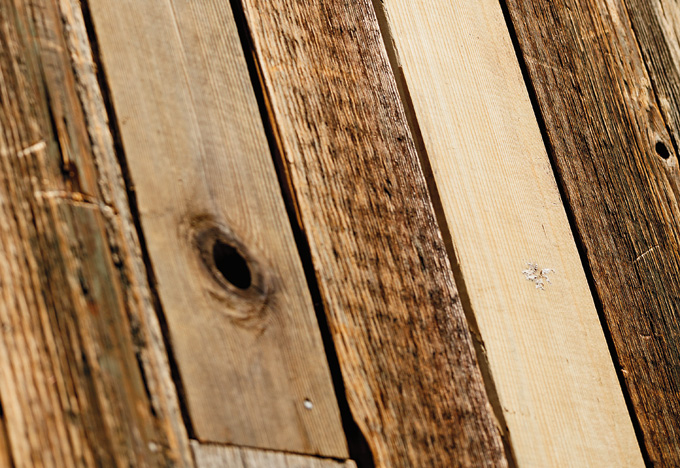 |
| The recycled barn-wood siding’s imperfections were intentionally exposed. |
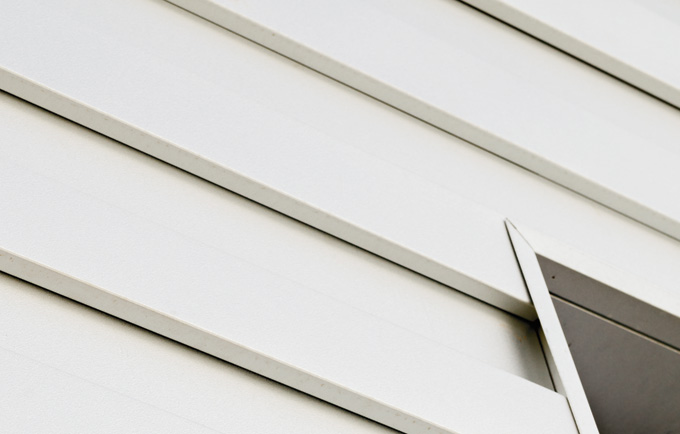 |
| Gift researched the corrugated metal siding, designed to last for 50 years. |
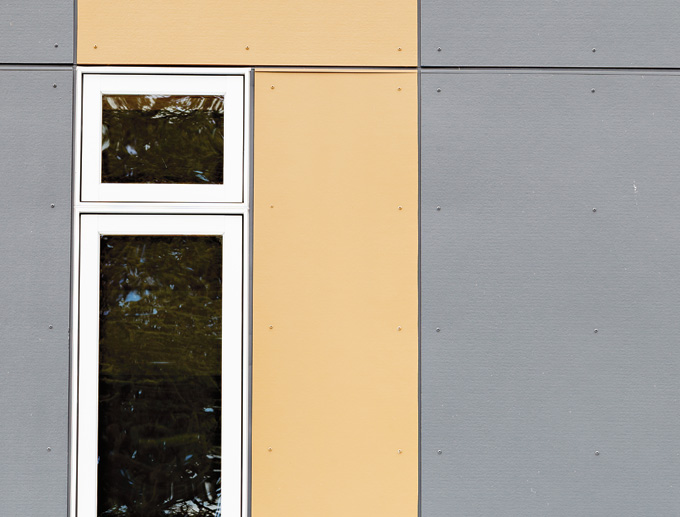 |
| The fiber cement panels were installed wrong-side out and painted gray. |
LOW-MAINTENANCE CONSTRUCTION AND MATERIALS
The home’s recycled and reclaimed materials, and its recycled structural steel frame and minimal finishes, help create a healthy environment. “We left most materials as they were,” says Peterman. “We wanted to show the paint graffiti on the barn wood, and the knots and imperfections in the stair treads. We don’t have any off-gassing, and we only used natural finishes, such as wax. Where we didn’t need to have a finish, we didn’t use one.”
SOLAR ENERGY
Five-kilowatt photovoltaic panels and thermal hot-water solar panels on a white heat-reflecting membrane roof allow for on-site, as-needed energy production, and the home can also return energy to the grid. The system can even be operated remotely. “We have remote heat sensors installed in several rooms, and I can check the system with my smartphone,” says Gift.
HEATING, VENTILATION AND COOLING
The home’s concrete floors and countertops allow for passive heat retention and cooling. The ground-source heat pump collects heat in the winter and reverses in the summer by pulling heat from the home. The Swiss heat-recovery ventilation system by Zehnder America provides continuous high-quality filtered fresh air. “The air quality in the house is great,” says Peterman. “The house never smells stale. It smells like fresh, clean wood.



